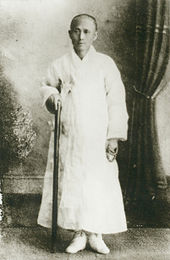- Daejonggyo
-
Daejonggyo Hangul 대종교 Hanja 大倧敎 Revised Romanization Daejonggyo McCune–Reischauer Taejonggyo Daejonggyo (Korean: 대종교, "The Religion of the Divine Progenitor"[1] or "Great Ancestral religion"[2]:192 also known as Dangungyo 단군교 (檀君敎) meaning "Religion of Dangun") is a religion of Korea founded in Seoul in 1909 by Na Cheol (나철).[1][3] The god of the religion is the legendary king Tan-gun or Dangun, who ruled over a Korean empire around 5000 years ago;[1] it is the best known of around 17 new religious movements that worship Tan-gun.[3] Its main tenet is that because the Koreans have their own God they have no need to worship foreign gods.[4] Its emphasis is on the national identity and unity of the Korean people (known as minjok) and as such has been associated with Korean nationalism (and sometimes ultranationalism).[2]:193 Its relatively unorganized nature, focusing not so much on institutions or rituals but more so on central doctrines and associated mythologies, makes Daejonggyo resemble a creed or a faith system rather than an organized religion. A 1995 census found that fewer than 10,000 Koreans claim to follow the religion.[3]
Na Cheol (1863–1916), known for his role as a leader of the Korean independence movement from Japanese rule, founded the religion in 1909 as its "Great Teacher" (tosagyo)[5] and named it first Tan'gun'gyo (Tan'gun religion) and then a year later Daejonggyo.[2]:192[1] He said that it was a revival of a belief in a Trinitarian god during the Koryŏ dynasty: the creator (Hanim/Hwanin), the teacher (Hanung/Hwanung) and the ruler (Tan'gun/Hanbaegŏm/Hanŏllim).[1][4] This theology appears to be influenced by Christianity, but the ethical basis of the religion is mainly similar to Confucianism.[1] The importance of Tan-gun was influenced by Shin Chaeho's A New Reading of History, and Tan-gun was emphasised over another legendary figure, Jizi (Kija), who was said to not be Korean in origin.[2]:192 Na claimed that the religion was approximately 4300 years of age, which would make it Korea's oldest religion. He said that until the early 1900s it was called Koshindo.
After the annexation of Korea in 1910 by the Empire of Japan, the new religion was spread in Manchuria by Na, where it set up schools and social centers, and became a focus of the Korean independence movement.[2]:193 Na committed suicide at a shrine on Mount Kuwŏl in 1916, saying that he had guilt over his failures and was martyring himself for the sake of his religion, God and people.[5] Leaders of the religion after Na include his successor Kim Kyohong,[2]:50 and An Ho-Sang.[1] The teachings of Dangun were said by Kim in his "History of the Divine Tan'gun's People" to be the sin-gyo or "divine teachings", and he said that various Korean religions, such as that of Wang Kon, were continuations of the sin-gyo, but that these beliefs had been suppressed under the Mongols, Buddhism, and Confucianism.[2]:194[4] The main task of the religion was chunggwang ("lighting anew"), meaning reviving the memory of Tan-gun.[2]:198
See also
References
- ^ a b c d e f g Chang, Yunshik; Hyun-Ho, Seok; Baker, Donald L. (2008). "Globalization and Korea's new religions". Korea confronts globalization. Routledge Advances in Korean Studies. 14. Taylor & Francis. pp. 211â212. ISBN 041545879X. http://books.google.co.uk/books?id=3-HxKjWqMEMC&pg=PA211.
- ^ a b c d e f g h Schmid, Andre (2002). Korea between empires, 1895-1919. Studies of the East Asian Institute. Columbia University Press. ISBN 0231125399. http://books.google.co.uk/books?id=oSXtk6uxrhgC.
- ^ a b c Connor, Mary E. (2009). "Society". The Koreas. Asia in focus. ABC-CLIO. p. 173. ISBN 1598841602. http://books.google.co.uk/books?id=j2gYgXGENM0C&pg=PA173.
- ^ a b c Baker, Donald L. (2008). Korean spirituality. University of Hawaii Press. p. 118. ISBN 0824832337. http://books.google.co.uk/books?id=RCBe9w9C2UkC&pg=PA118.
- ^ a b Ch'oe, Yongho; Lee, Peter H.; De Bary, William Theodore (2000). Sources of Korean Tradition: From the sixteenth to the twentieth centuries. Introduction to Asian civilizations: Sources of Korean Tradition. 2. Columbia University Press. p. 331. ISBN 0231120311. http://books.google.co.uk/books?id=A9LoA9L1ABcC&pg=PA331.
External links
- (Korean) Official Site
Categories:- Religion in Korea
- New religious movements
- Monotheistic religions
- Religious organizations established in 1909
- Korea stubs
Wikimedia Foundation. 2010.

